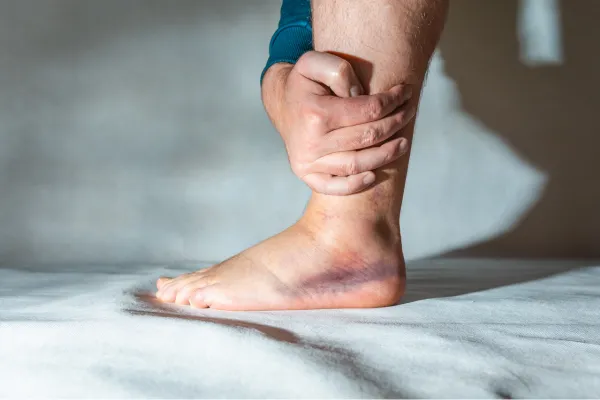
Swollen Ankles After Walking? Here's What Might Be Going On
Are Your Ankles Puffy, Achy or Tight After a Walk?
If you’ve noticed your ankles swelling after walking—even short distances—you’re not imagining it. This is a common issue we see at Coventry Foot Doctor, and it can have several underlying causes.
Sometimes it’s something mild and temporary. Other times, swollen ankles can be a sign of something more serious going on with your joints, tendons, or circulation.
Let’s break it down so you can understand what your body might be trying to tell you—and what to do next.
First, What Does Swelling Actually Mean?
Swelling happens when fluid builds up in the soft tissues of your ankle and lower leg. It can feel:
Puffy or tight
Achy or tender
Warm to the touch
Worse after being on your feet
Sometimes discoloured or red
Occasional swelling may not be serious, but if it keeps happening, or it’s getting worse, it's time to get it checked out.
Common Causes of Swollen Ankles After Walking
Here are the most common reasons we see in clinic:
1. Tendonitis
If you’ve strained the tendons in your foot or ankle (like the Achilles tendon), you may get inflammation that leads to swelling.
Usually caused by overuse or poor footwear
Pain often increases with movement or activity
Might feel stiff in the morning or after rest
2. Arthritis
Osteoarthritis or rheumatoid arthritis can affect the ankle joints, causing pain, stiffness, and swelling—especially after walking or standing.
Common in older adults or those with a history of joint pain
Might notice limited movement or a grinding feeling
Often worse at the end of the day
3. Poor Circulation or Fluid Retention
Sometimes your veins aren’t working efficiently to return blood to the heart, especially after movement. This leads to fluid pooling in the lower legs and ankles.
Swelling often affects both ankles
May feel heavy, tired, or “tight” in the legs
More noticeable after long walks or standing
4. Injury or Overuse
You might not realise you’ve strained something—especially if you're walking on uneven ground or wearing unsupportive shoes.
Swelling may appear suddenly after a twist or misstep
Could be tender, bruised, or painful to touch
Might feel better with rest, worse with movement
5. Medication or Health Conditions
Swelling can be linked to certain medications or conditions like:
High blood pressure
Heart or kidney problems
Diabetes
Hormonal changes
What You Can Try at Home
If the swelling is mild or new, here are a few simple things that might help:
Rest and Ice – Elevate your foot and apply a cold pack
Compression Socks – Can improve circulation and reduce fluid buildup
Supportive Footwear – Avoid flat, unsupportive shoes or worn-out trainers
Gentle Massage – Can help move fluid and reduce discomfort
Stay Hydrated – Helps your body flush out excess fluid
If swelling continues or worsens, it’s time to get it checked out properly.
How Coventry Foot Doctor Can Help
We specialise in identifying and treating the root cause of foot and ankle problems.
Here’s what we offer:
Detailed Assessment – We look at your walking pattern, joint health, and circulation
Accurate Diagnosis – From arthritis to tendonitis, we’ll find out what’s behind the swelling
Tailored Treatment Plan – Including exercises, orthotics, footwear advice, or referrals if needed
Ongoing Support – Especially important for patients with diabetes or circulation issues
Our goal is to help you move comfortably, without pain or puffiness holding you back.
Don't Let Swollen Ankles Slow You Down
You don’t have to “just live with it.” Swollen ankles are your body’s way of saying something needs attention—and we’re here to help you figure out what that is.
Book Your Appointment Today
If walking is causing ankle swelling or discomfort, let’s find out why—and fix it.
Contact us at Coventry Foot Doctor to book your consultation and start feeling better, step by step.
Ask Abid And His Team
Fill in the form to request a Call From Our Team
One of our team will call you for FREE and answer any questions or concerns you may have about your uncomfortable Foot Pain
© Copyright 2022. Biomechanix Clinic Ltd. All rights reserved.





